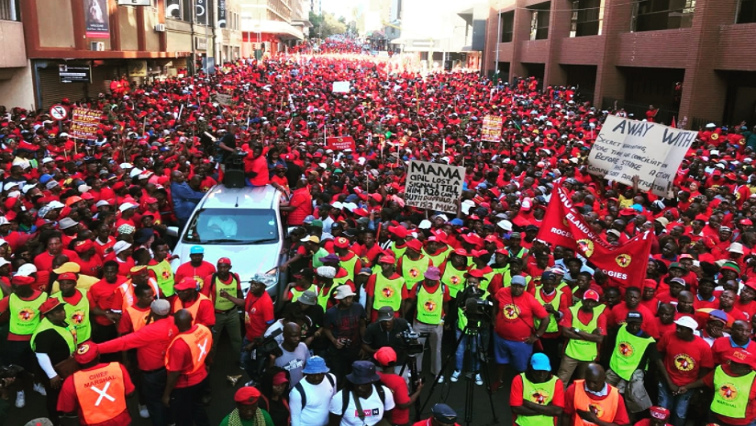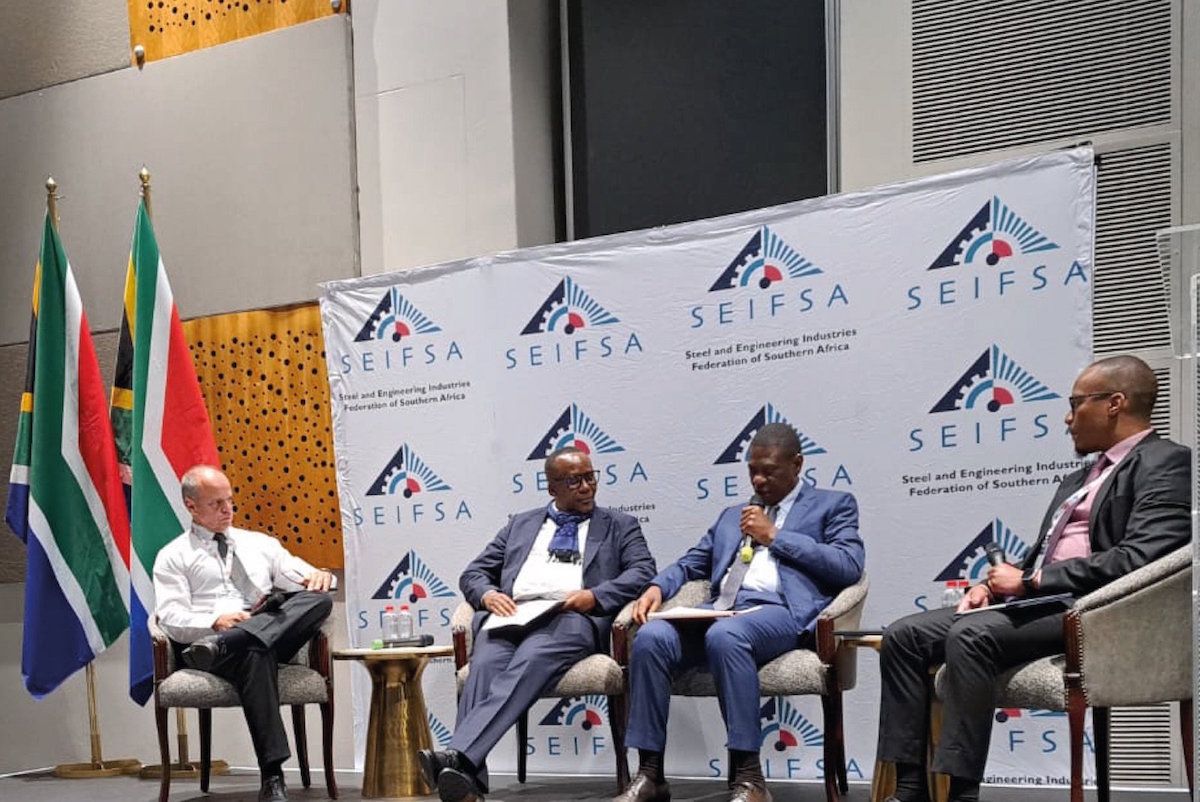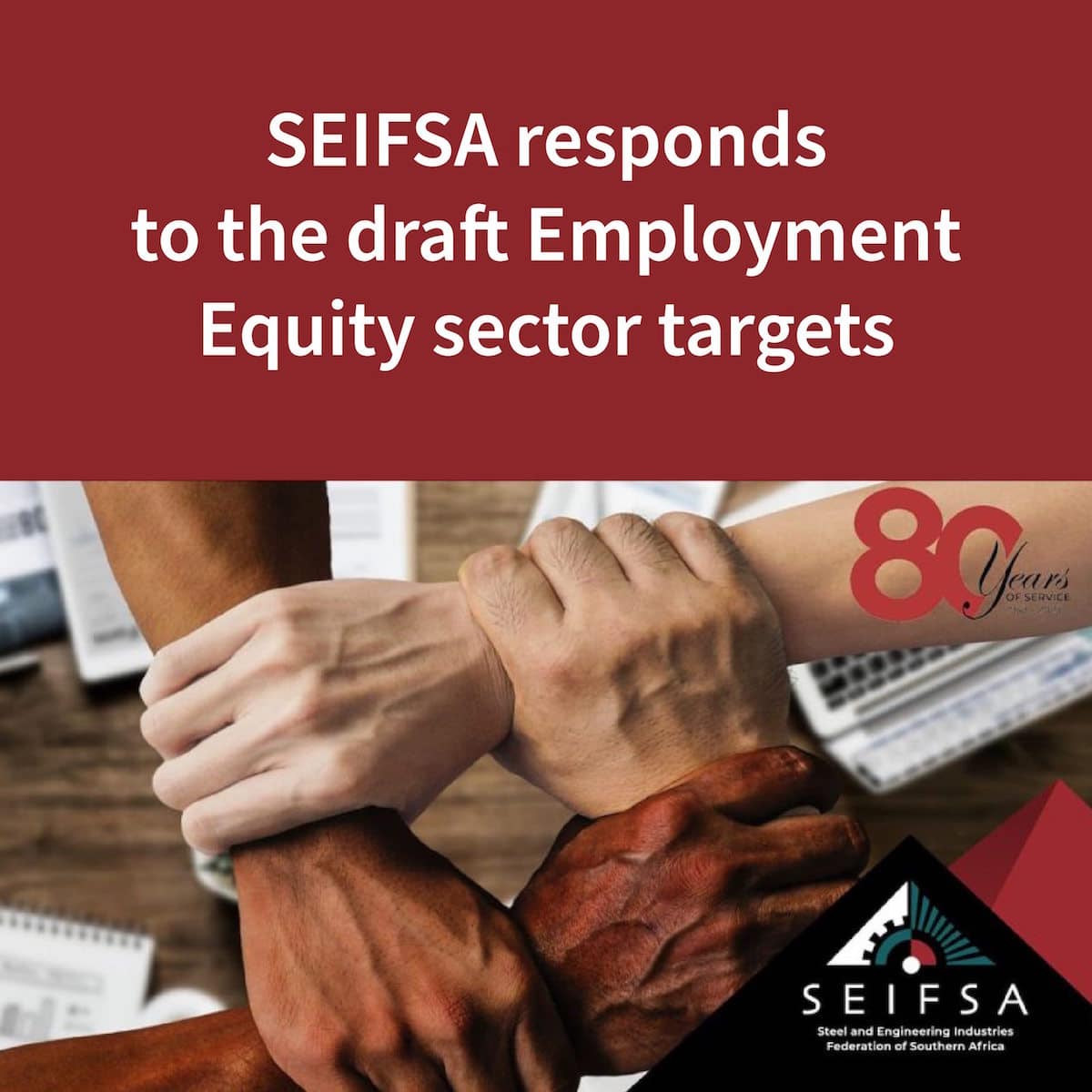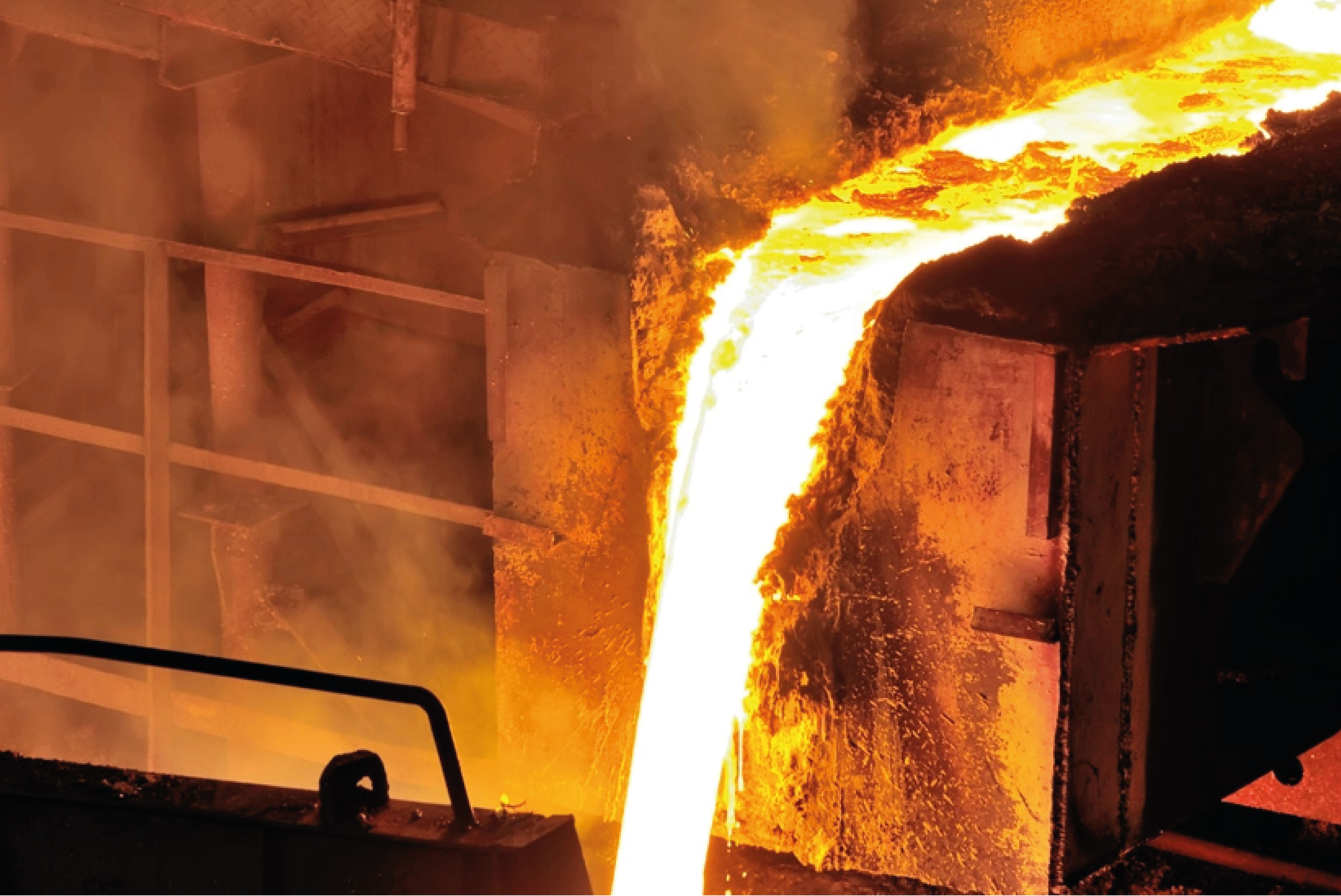The collapse of the Steel Master Plan and disintegration of industry
The steel industry is the backbone of any economy, it forms the foundation of any modern economy and is essential to every single sector. Without a healthy and vibrant local steel industry, South Africa will simply not be able to integrate and develop itself or the rest of the continent. The steel sector – and South Africa – urgently needs clarity on policies, consensus on action plans and realised deliverables on the ground in order to instil confidence in the viability of the country to boost competitiveness and attract both local and foreign direct investment.
The recent announcement by ArcelorMittal South Africa on the potential closure of its operations in Newcastle and Vereeniging, as well as ArcelorMittal Rail and Structural presents a major set-back to the base of the industrial sector and industrialisation more broadly. This development also raises the sharp question whether the grand aspirations of the Steel Master Plan (SMP) to reindustrialise the steel industry are beginning to disintegrate under our watch. The unfortunate reality is that the lofty goals set by the SMP to charter a roadmap to reenergise the sector, expand production and demand across the steel and fabrication value chain are becoming increasingly illusive. There is a growing sense on the part of industry that the SMP has collapsed.
The SMP was pitched as the platform through which all the stakeholders, namely; government, business and labour, who have a direct and vested interest in seeing this industry prosper, would come together and work collaboratively to meet this end. The plan was sold as a deviation from the old and unproductive approach where government directs the path which industry should take and one where different stakeholders lobby the government toward their respective ends in an unstructured way. It was meant to be a unifying platform, where meaningful and active collaboration took place to arrest the rapid decline currently being experienced by the industry through short-term interventions and to grow the industry through longer dated interventions. Importantly, it was also meant to open avenues of communication and collaboration between all stakeholders.
The metals and engineering industries, and particularly the constituency I represent through the Steel and Engineering Industries Federation of Southern Africa (SEIFSA), fully committed itself to the SMP when it was launched in 2021. SEIFSA was a signatory to the founding document and nominated a number of captains of industry to lead various workstream. The SEIFSA team has invested considerable resources to the work of the SMP unlike some of the nay-sayers that wrote-off SMP at the outset.
Over the last year, SEIFSA has made numerous formal requests for a meeting with the Minister of Trade Industry and Competition on the scrap metal export ban and other much wider and arguably more important and strategic industrial policy concerns. Disappointingly, the meetings have not materialised and our requests have fallen on deaf ears.
We understand and acknowledge that Ministers leading key departments and portfolios are extremely busy, but what we cannot accept is the lack of decisive leadership from the DTIC, resulting in numerous decisions being strung out and not forthcoming. That said, it is ironic that some decisions, like the ban on scrap metal exports – with all its adverse implications – received priority preference and relatively fast decision turn-around times. A further concern to business is the delays in appointing permanent staff to critical decision-making roles. A significant number of DTIC staff, in key decision-making roles, hold them in an acting capacity and this in part contributes to the delays on decision-making.
Public consultation processes on regulations which are often undertaken when it is seemingly clear that a decision has already been taken. This suspicion on the part of business is supported by the unwillingness of the ministry to engage industry on a more in-depth basis on some of the more rational proposals submitted by industry, as in the case of the scrap metal export ban. Moreover, relating to the same scrap metal export ban there has been a very concerning shift in the goal post where the motivation to extend the export ban is now leaning to input cost support for the scrap-based mills and the country’s decarbonisation efforts, whereas the original reasons used to force the decision through were of a security nature and protection of infrastructure. Introducing industrial policy by stealth and misleading economic signals as in this case, renders the SMP as a platform to rubber-stamp and legitimise decisions, including those that do not enjoy support and alignment by a significant block of employers.
Overarching all of this is the fact that the SMP was meant to deliver a comprehensive industrial policy framework, where a total industry perspective would be taken and complementarities across the value chain enhanced. Sadly, what we are witnessing is the opposite, wherein policy is implemented in a fragmented manner, with a short-term view and with pockets of industry being pit against one another. The scrap metal export ban is one such divisive and market distorting development.
The industry is quickly losing faith in the SMP process and it is obvious but worth mentioning that the withdrawal of this constituency from the SMP would virtually render the plan moot. Industry simply cannot continue to invest the amount of time, effort and resources as it has done thus far for altruistic reasons, particularly when the experienced reality is one of a continued deterioration of the business and operating environment, company closures and job losses.
Elias Monage
SEIFSA President
SAFTU’S Intended protest action 29 November 2023
Introduction
Management may be aware, from recent media reports, that the South African Federation of Trade Unions (SAFTU), intends calling workers to support a socio-economic protest action on Wednesday, 29 November 2023.
Protest Action and the Labour Relations Act
The Labour Relations Act (LRA) permits registered trade unions or federations such as SAFTU, of which NUMSA amongst others is a member, to undertake protected protest action to promote the social and economic interests of workers provided that they observe the procedural requirements contained in Section 77 (1) (b) of the LRA 66 of 1995, as amended.
This application was duly considered by NEDLAC and the NEDLAC Section 77 Standing Committee has determined the notice to be compliant with the administrative requirements of the LRA. COSATU can therefore go on protest action based on their notice submitted on NEDLAC on 10 November 2023. Procedurally, they have met the requirements.
Consequently, any employees participating in any action on 29th November 2023 will be protected by the normal rules regarding protected strike-action, namely: no-work-no-pay and no disciplinary action.
Management Guidelines on Possible Absenteeism on Wednesday, 29 November 2023
SEIFSA recommends that management adopt the following course of action in dealing with any stay-away from work on the 29th November:
- Inform all workers that any absences related to the protest action will be treated on the following basis:
- no work, no pay;
- no disciplinary action for participation in the protest action but excluding any misconduct during the protest;
- a shift for leave-pay and leave-enhancement pay qualification purposes will be lost in respect of the day’s absence; and
- any overtime worked during the course of the week will be paid at ordinary rates to make up for the lost ordinary working hours from Wednesday, 29th November 2023.
The Staff of the SEIFSA Industrial Relations Division are available on (011) 298-9400 to provide any further advice and/ or assistance to management on the contents of this management brief.
22 November 2023
Deputy President Paul Mashatile meets Metals Industry Top CEOs
Deputy President Paul Mashatile met the Steel and Engineering Industries Federation of Southern Africa (SEIFSA) Board and Executives as well as the sectors top CEOs at a breakfast roundtable at the Radisson Hotel & Convention Centre at OR Tambo on Friday, 14 July 2023 with the aim of opening the channels of dialogue between the Deputy President’s Office and this strategic sector of the economy.
The event gave CEOs the opportunity to engage government on working together in partnership to removing obstacles to economic growth and job creation. In addresses from the Deputy President Mashatile, SEIFSA CEO Lucio Trentini and Federation President Elias Monage, as well as during an open question-and-answer session, the dominant theme of the event was the dire need for greater collaboration between government and business in removing obstacles to growth and job creation.
Mashatile, who took over as Deputy President in March 2023, stressed the importance of restoring business and investor confidence in the industry, as well as the wider economy. He said government is committed to implementation and to creating strong ties with industry. The breakfast roundtable was the beginning of a process of engagement between the two parties, he said.
Monage said SEIFSA has made real headway in developing an integrated approach to dealing with the country’s many challenges. He emphasised the need for government and business to co-operate in order to properly address issues such as low economic growth, stubborn unemployment and to be open to new collaborative efforts. "We need to be doing things differently to get different results," he said.
In his welcoming address to the roundtable, Trentini said South Africa was not close to meeting its potential, so "there is no time to waste in jumpstarting economic growth.”
“The stark reality is that three decades into our young democracy – the overriding story of the South African economy remains one of a country that is not reaching, let alone fulfilling, its potential in many areas – in short, the country’s current economic growth, job creation prospects and industrial development efforts are less than encouraging,” he said.
This initiative builds on the success of the meeting held with President Ramaphosa on 18 April 2023 where SEIFSA and Government agreed on the need for an urgent collaborative solution-based approach aimed at reigniting economic growth and securing the metals and engineering sectors future sustainability. Immediately following this meeting three priority workstreams were established focusing on demand creation, increasing exports into Africa and skills development.
The meeting with the Deputy President, as the leader of Government-Business relations, is aimed at strengthening and deepening this collaborative partnership and facilitating movement beyond policy formulation to project implementation.
To read the full government press release click here.
ENDS
SEIFSA responds to the draft Employment Equity sector targets
In response to a call for public comment the Steel and Engineering Industries Federation of Southern Africa (SEIFSA), representing 18 Employer Organisations, who collectively represent in excess of 1 300 companies, employing approximately 173 000 employees, submitted the following.
The metals and engineering sector is an integral part of the global and domestic economy. It constitutes 26% of the manufacturing and contributes 2.6% directly to the country’s gross domestic product (GDP). SEIFSA’s affiliated members in the sector constitute the entire metals value chain from metal production, merchants, metal fabrication, heavy and light engineering. The sub-industries that make up the sector are contained in the table below.
The sector is a crucial supplier of inputs into major sectors such as agriculture, mining, the automotive sector, construction and other manufacturing sub-industries.
The sector is also a strategic avenue through which the country converts its vast mineral endowment to final engineered products, domestically.
| Economic Variable | 2020 | 2021 | 2022 |
| M&E GDP (Rand billion) | R115.7 | R130.6 | R131.1 |
| Share of GDP | 2.5% | 2.6% | 2.5% |
| Capacity Utilisation | 66.6% | 75.5% | 75.8% |
| Employment (number) | 371955 | 371390 | 374496 |
| Total Sales (Rand billion) | R638.5 | R809.4 | R914.2 |
| Export Sales (Rand billion) | R256.1 | R323.5 | R342.9 |
Source: Statistics South Africa, SARS, MIBFA
Despite the potential of the sector, the graphs hereunder are the most effective way of communicating the distress that the sector has experienced over the last 15 years.
Production trends have been on a structural downward trajectory since the 2008/ 2009 global financial crisis, from which the sector has never fully recovered. The sector for all intense and purposes has been in a structural recession since 2008.
As is to be expected, the sector was not spared from the economic disruption of Covid-19. Whilst a sharp recovery has been noted, production levels are still 5% below pre-covid levels.
On the employment front, the sector has lost 205 926 jobs from the 2008 peak of 577 502 to the current employment count of 374 496. As the global economic environment deteriorates, more intense head-winds are anticipated for the sector.
With the official unemployment rate edging above 33% there seems little prospect for improvement in the near future, especially with loadshedding continuing to wreak havoc on our sector and the broader economy as a whole. The electricity crisis, resulting in up to 16 hours of electricity cuts for some industrial areas, eats into everything that powers an economy that has hardly grown for more than a decade. The number of unemployed people should instil a sense of urgency into fixing the economy. Failing that, we run the risk of entrenching the kind of poverty that can upend the social compact that underpins our democracy.
The metals and engineering sector is therefore in structural decline, both in terms of economic performance and employment. This presents a structurally constrained environment, one where opportunities for new employment creation is limited.
In setting the context, we refer to the graph on the previous page. You will note that not only has production in the sector averaged 15% below its 2008/9 peak, but it has also has recorded a multi-year contraction of - 1.3% (CAGR), over this period.
In 2023, SEIFSA estimates that production in the sector could contract by a further 5.3% if the impact of load-shedding is factored in. Moreover, production of the metals and engineering sectors is a function of economic activity and infrastructure spend, both of which have disappointed over the last 10-15 years.
The table below depicts the trends of both variables (GDP and gross fixed capital formation) over these periods. It is evident that the trends are deteriorating when the decade is compared to the 15-year period.
|
Variable |
10 years | 15 years |
| GDP Growth | 1.1% | 1.3% |
| Gross Fixed Capital Formation Total | - 0.9 | 0.8% |
| Gross Fixed Capital Formation General Government | -1.5% | 1.2% |
| Gross Fixed Capital Formation Public Corporations | -5% | 1.8% |
| Gross Fixed Capital Formation Private Sector | 0.2% | 0.6% |
| Construction Sector Activity | - 2.1% | 0.7% |
Source: Statistics South Africa
The above generally explains the resulting trends noted in the metals and engineering sector.
Another important point to highlight is the evident decoupling between production and employment trends. This relationship has continued to widen over the last 15 years. The current estimates indicate that it takes a five percent increase in production to induce a one percent increase in employment. Therefore, the context of declining production as already presented earlier, does not bode well for employment prospects.
SEIFSA’s submission is that in such an environment of structural decline and a limited market that is also shrinking, the sector is unlikely to attract new entrants and the transformation consideration has to be considered through this lens.
The economy is expected to flatline barely above recessionary territory on a medium-term basis, which will undoubtedly lead to the upending of businesses (large, medium and small) and prospects of employment opportunities. The combination of high inflation in a weak demand environment - which has a negative carry-on profit margins - and high interest rates – which are inversely related to new investment – the outlook for the sector is bleak.
The net effects, certainly in the short-medium term, will be that companies will simply be unable to meet the proposed sectoral targets, human capital and skills development will be severally hampered and so will the valuable and positive investments that companies have in community work, supplier development initiatives etc., with companies simply opting to closing shop.
The proposed sectoral targets have come as a surprise as the Amendment Act, although assented to earlier this year, is not yet in effect. The Regulations are therefore premature and, if challenged, may be considered ultra virus.
We are firmly of the view that the Department erred in halting the consultation processes it was busy following with the different Sub-Sectors and Sectors as provided for in the Act and publishing only Sector Targets for the main sectors in an attempt to hopefully achieve implementation of Sector Targets on 1 September 2023. By doing so, it has opened itself up to legal challenges, which will inevitably lead to this implementation date not being achieved and the process that the Department had quite rightly embarked upon, being further halted until the exhaustion of the ensuing legal proceedings.
This will, in all likelihood, result in the implementation of Sector Targets being delayed for far longer than it would have been, had the Department continued with its consultation processes and not tried to fast-track the implementation of Sector Targets on 1 September 2023.
The Department is therefore urged to reconsider this course of action and to firstly conclude the engagements and processes that started with the different Employer Organizations in the different Sectors and Sub-Sectors, before re-issuing Sector Targets.
SEIFSA’s Collective Bargaining Summit to get to grips with labour issues in Metal Industries
The steel and engineering sector will have a chance to analyse and constructively debate the pros and cons of current collective bargaining practices that have dominated the manner in which employers and trade unions have engaged one another in the sector over the past 60 years at the Metal Industries Collective Bargaining Summit at Emperors Palace on May 24 and 25 2023.
The summit, organised by the Steel and Engineering Industries Federation of Southern Africa (SEIFSA), will see captains of industry, union leaders, senior government ministers and expert analysts discuss the many challenges facing the sector, including crucial debates around conditions of employment and labour costs. Employee costs make up 20% of total costs in the metals and engineering sector.
“A well-functioning economy needs business, labour and government to be in agreement in terms of policy. Our economy has been under enormous pressure since the global financial crisis; we are dealing with crippling youth unemployment, a sub-investment status, stagnant growth and the lingering effects of the Covid-19 pandemic. We hope the summit will plant the seed amongst all stakeholders that in order to begin addressing our many challenges, we need to find a better way of working together,” says SEIFSA CEO Lucio Trentini.
Speakers and panellists across the business, labour and government divide will debate a wide range of issues that underpin the current collective bargaining model, the importance of labour market stability in unlocking economic growth and developing a shared vision on how together we potentially can move forward; topics to be covered include the following:
- Very tough times ahead if we do not turn this ship around — and fast by Dr David Masondo, Deputy Minister of Finance;
- The implications of declining union representation in bargaining councils by Thulas W Nxesi, the Minister of Employment;
- The relevance of the current form of central wage bargaining by Afzul Soobedaar, Director at Perispec Consulting;
- Democratisation of the workplace and the strategic importance of what transformation means in the industry and economy by NUMSA General Secretary Irvin Jim;
- Opportunity for unions to re-emerge as a united force? by Gideon du Plessis, General Secretary of Solidarity; and
- What is the future of trade unions and collective bargaining in a reimagined industrial relations framework? by Jonathan Goldberg, Chief Executive Officer of Global Business Solutions.
Macsteel, RMA and Cachalia Capital have put their weight behind the Metal Industries Collective Bargaining Summit as partners, with Engineering Weekly the Summit’s official media partner.
“If we are to put our economy back on track, it is crucial that decision makers from business, labour and government discuss these issues with a view to addressing the many challenges that face us; the Metal Industries Collective Bargaining Summit offers the opportunity to do this,” says Trentini.
SAFTU’S Intended protest action 20 March 2023
Introduction
Management may be aware, from recent media reports, that the South African Federation of Trade Unions (SAFTU), of which NUMSA is a member, intends joining the Economic Freedom Fighters’ (EFF) call for a national shutdown on 20 March 2023.
Protest Action and the Labour Relations Act
The Labour Relations Act (LRA) permits registered trade unions or federations such as SAFTU, to undertake protected protest action to promote the social and economic interests of workers provided that they observe the procedural requirements contained in Section 77 (1) (b) of the LRA 66 of 1995, as amended.
This application was duly considered by NEDLAC and the NEDLAC Section 77 Standing Committee has determined the notice to be compliant with the administrative requirements of the LRA. SAFTU can therefore go on protest action based on their 1(b)-notice submitted in 2020, and their latest 1(d) notice. Procedurally, they have met the requirements.
Consequently, any employees participating in any action on 20th March will be protected by the normal rules regarding protected strike-action, namely: no-work-no-pay and no disciplinary action.
Management Guidelines on Possible Absenteeism on Monday, 20 March 2023
SEIFSA recommends that management adopt the following course of action in dealing with any stay-away from work on the 20th March:
- Inform all workers that any absences related to the protest action will be treated on the following basis:
- no work, no pay; no disciplinary action;
- a shift for leave-pay and leave-enhancement pay qualification purposes will be lost in respect of the day’s absence;
- any overtime worked during the course of the week will be paid at ordinary rates to make up for the lost ordinary working hours from Monday, 20th March February 2023; and
- Management is at liberty to explore the possibility of arranging mutually acceptable alternative work-in-time arrangements in view of the Monday being sandwiched between a week-end and a public holiday on the 21 March 2023.
The Staff of the SEIFSA Industrial Relations Division are available on (011) 298-9400 to provide any further advice and/ or assistance to management on the contents of this management brief.
BUSA on President Cyril Ramaphosa cabinet reshuffle
We note the announcement by President Ramaphosa of his reshuffled cabinet. The appointment of Dr Kgosientsho Ramokgopa as Minister of Electricity is a critical one and we will engage him urgently to see what his thinking is on dealing with the short-term loadshedding crisis and the medium-term energy crisis. We were of the view a new Minister of Electricity should not be appointed, but now that the President has appointed him, we will continue our support to help implement the President’s Energy Plan as a matter of urgency. He will have a significant challenge in coordinating roles between his department and that of the Minister of Resources and Energy and how he utilises the powers accorded to him under the State of Disaster.
Numerous new ministers are new people and we will wait to see what announcements they make about their plans and strategies and we will expect significant improvement in policy formulation and, particularly in implementation. We also expect to see a Cabinet that is aligned behind the President’s vision and one that speaks with a single voice.
The Cabinet will have to demonstrate, with urgency, that ministers will be moving with speed to address the numerous crises we are experiencing in our country. The ministers do not have the luxury of taking their time in getting into their roles, but must move with urgency and implement, implement, implement!
Business has consistently indicated its readiness to work with government to shift the needle significantly in attracting investment and putting our country onto a sustainable and inclusive growth path. We remain committed to pursue this and urge relevant ministers to collaborate with us in a real partnership.
We will look out with great interest for urgent indications from the Cabinet about its priorities in the next few weeks. We will, on the basis of such indications, engage and see if there are possibilities of working together. But we will also continue to hold Cabinet, and the President, to account to show decisive leadership and act with urgency to rebuild trust of government amongst South Africans and to instil confidence amongst investors.
ENDS
Cas Coovadia
Business Unity SA CEO
SEIFSA welcomes the 2023 national budget
The 2023 National Budget recognises, reflects and has been structured to respond to key headwinds facing the global and South African economy.
The budget has maintained fiscal prudency – achieving a primary surplus - in an uncertain macroeconomic environment, without resorting to unsustainable borrowing and punitive tax proposals.
These headwinds include slower global economic growth, presenting a less supportive environment for the South African economy, thereby limiting the revenue side of the equation. Additionally, higher interest rates, globally, which increase debt service costs, estimated to be R340.5 billion (just under R1 billion per day) in the 2022/3 fiscal year, at a time when the State will be taking on R254 billion of Eskom’s debt also contributes to a difficult budgeting environment.
The recognition of the binding constraint that the energy crisis presents to the South African economy and the proposals set-out in the budget to deal with this risk are welcomed.
SEIFSA has consistently highlighted that while it is important to stabilise Eskom, and the debt relief package does that, the broader solution lies in allowing an accelerated deployment of generation capacity by businesses and households.
To this end, the tax measures allowing companies to recoup 125% of the capital cost of renewable energy investment, without limitation to the size of capacity installed, and the 25% rebate afforded to households for solar installation are welcomed.
However, while National Treasury’s intention to induce this investment in the short-run by caping the window of these incentives to two and one year for companies and households, respectively is noted, SEIFSA submits that longer timeframes should be considered, given the extent of the energy crisis.
At a bare minimum the period should be the medium-term expenditure framework (next three fiscal years) or five years. Moreover, the precarious state of the economy at the current state and into the next fiscal year for companies and households, means that these economic agents have limited financial resources to make the energy investments. The risk of the very short timelines considered for these tax measures will lead to the measures only being taken up by companies that have the financial resources at the present moment, thereby limiting the full potential of the measure. The same observation regrettably applies to private households.
The budget estimates that R903 billion will be spent on infrastructure over the medium-term expenditure framework, which is a key point to highlight for the metals and engineering sector, a sector whose performance is driven by infrastructure spend. However, we note with concern the envisaged finalisation of the Public Procurement Bill, which National Treasury anticipates only to table through the parliamentary process in March 2023.
In the continued absence of finalising this bill, there is considerable uncertainty around procurement by state organs, and particularly around aspects of preference for local companies.
SEIFSA continues to call for an urgent and accelerated finalisation of the Public Procurement Bill to limit the opportunity being lost to domestic industrialisation.
SEIFSA Releases State of the Metals and Engineering Sector Report
The outlook for the Metals & Engineering (M&E) Sector this year is decidedly bleak, according to the State of the Metals and Engineering Sector Report, which the Steel and Engineering Industries Federation of Southern Africa (SEIFSA) released this week.
The report, which was presented in a webinar on February 16, explores the current state of the Metals & Engineering (M&E) Sector, the structural dynamics underpinning the sector and the global and domestic economic indicators that influence the sectors outlook for 2023.
SEIFSA Chief Operating Officer Tafadzwa Chibanguza, describes the current global environment as extremely challenging. Inflation emanated as one of the most significant global headwinds in 2022, with the conflict in Ukraine and China’s slowdown – from the perspective of the country being the world’s factory – feeding inflationary pressures. Central banks around the world have had to adopt a much more aggressive stance to fight the stubbornly high inflation, and the implications of the monetary policy are starting to bite and will shape the economic fortunes for the year. A global economic slowdown is expected, tighter financing conditions have exposed fiscally vulnerable emerging markets, all of which represent markets for the M&E Sector which exports 38.2% of output, with half of the exports going into Africa. Local headwinds, primarily the energy crisis, only serve to compound the already inhospitable environment. The sectors to which the M&E Sector supplies domestically, namely: construction, automotive, mining and petrochemicals, have all indicated a difficult year ahead, with the energy crisis being a chief contributor.
"Based on these multiple challenges, SEIFSA expects production for the M&E Sector as a whole to contract by 2.2 % in 2023," says Chibanguza. The best-case scenario estimates a contraction of 1.5% for the sector.
To place this figure in context, production for the sector increased by 1.6% in 2022, although the sectors gross domestic product (GDP) contracted by 6.5% in the same year.
The report also highlights the key reform programmes and policies needed to drive the sector’s performance, which is closely tied to economic activity and underpinned by prevailing economic fundamentals.
"There is not much we can do with external factors — we are either a victim or beneficiary of these, such as the conflict in Ukraine. But domestically there is a lot more we can and should be doing, especially when it comes to the energy crisis, which is a risk to the whole economy," says Chibanguza.
The energy crisis has far-reaching implications from water provision, risks to general service delivery at municipal level, which has been accompanied by increasing instances of protest action. Resolving this one area ticks many boxes, while simultaneously contributing in part to unlocking the economy’s underling potential.
The report provides an in-depth analysis of the effect of the toxic combination of load-shedding, dismal service delivery and a depressed global economic environment and the implications on an already-beleaguered M&E Sector.
View the PowerPoint presentation here: https://bit.ly/3I5bsFN
Watch the webinar recording here: https://bit.ly/3YRWjyf
BUSA Reaction to State of the Nation Address (SONA)
This SONA was delivered amid severe crises across critical economic and social spheres in our country. These include the energy crisis, the logistics crisis, the law-and-order crisis, the water crisis, and the governance crisis. We welcome the President’s acknowledgement of these crises facing our country and for outlining measures to address them. The speech outlined some good ideas, as well as bad ones.
It is of concern to business that the President referred to our nation as being defined by hope and resilience. He also said “better late than never” in the context of delays in implementing numerous commitments. Our nation should not have to depend on hope and, in the crises, we face, we cannot afford to be late in implementation.
The President rightly referred to the devastating impact of Covid 19, on livelihoods, the economy and loss of life. What is different however, is that the crises we face today are primarily because of poor governance and lack of decisive leadership, exacerbated by a weak state that is hesitant to work in a real partnership with business, despite several offers by business to support, and work with, government. The speech provided no detail of how government plans to work with stakeholders such as business and we expect that the details will be provided in his response to the SONA debate next week.
We recognise the positive changes since the SONA in 2022. These include the launch of spectrum, lifting the ceiling on embedded energy, going to market on a further tranche of renewable energy and the announcement of a comprehensive energy plan by the President. However, this is where the “better late than never” issue is problematic. All these positive developments should have been announced 4 years ago and implemented then, something business has consistently been calling for. If the embedded energy ceiling had been lifted 4 years ago, when business called for it, the energy environment would be looking very different today. Despite these delays, business responded positively and urgently and 3.6GW of energy will be on the grid in the next two years from investments in embedded energy.
We welcome the concentration in this SONA on the energy crisis, however we are not convinced that declaring a State of Disaster will help address the crisis. It must be seen as a low point in the life of our society that mismanagement and lack of governance has created circumstances in which a State of Disaster has to be declared. We believe the appointment of a Minister for Electricity in the office of the President is a bad idea that will add to the confusion and turf wars rather than solve the problem. It is yet another example of failure to take bold decisions and opting instead for the soft but expensive option of adding another ministry rather than holding those ministers responsible for the crisis accountable.
Business is concerned about the potential of a repeat of corruption we saw under the Covid-19 State of Disaster, although we welcome the announcement that the Auditor-General will oversee use of resources. We welcome the announcement on rooftop solar panels and that provision will be made in the budget speech to incentivise this. We also welcome the President referring to economic opportunities in an effective just transition pathway. One of the positive ideas from the President is the indication that he will establish a structure for social partners to engage on the energy crisis.
Our view is that unemployment can only be addressed sustainably through attracting investment and putting our country onto a sustainable and inclusive growth path. This requires fundamental reforms in the economy and business has done a lot of work on this, which we are still keen on working with government on.
We urge government to demonstrate its commitment to working with other stakeholders in society such business. Implementation through bilateral initiatives will help develop a workable social compact that is anchored on practical implementation rather than mere words on paper.
We welcome the awarding of road construction contracts by SANRAL but urge that this process stays the course and there is certainty in contracting over the full period of the projects. The allocation of 600 million to Infrastructure SA for project preparation is welcome, however, we urge that focus should be on 4 or 5 major infrastructure projects that will contribute to economic growth to market rather than many small projects.
We also welcome progress on bringing corruptors to trial and the return of over R 7 billion to the state. There is a concern that so far, the ringleader involved in corruption have not been brought to book.
We are encouraged that the most vulnerable sectors of society will receive protection through the social wage in the budget and welcome the retention of the Social Relief of Distress Grant.
In conclusion, the SONA in our opinion, does not instil confidence that the structure of government is operating efficiently, and lack of performance and delivery will be held to account. We will follow progress on the announcements made, but emphasise that the critical focus must be on an enabling environment for investment and growth creation. Everything must be measured against that. We also await the restructuring of government to see if the President appoints a capable and lean cabinet that is fully aligned behind his vision and ministers are held accountable if they are not aligned. Finally, the priority areas remain energy, law and order, logistics and water. Business continues to urge government to work with us to implement quick solutions to these crises.
ENDS
Cas Coovadia
Business Unity SA CEO








